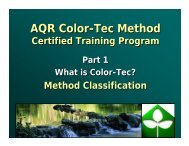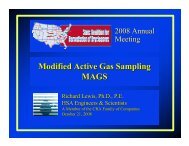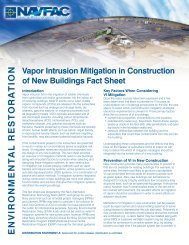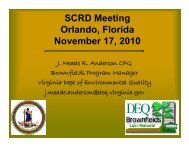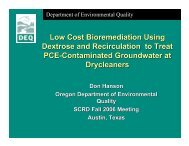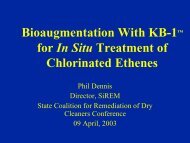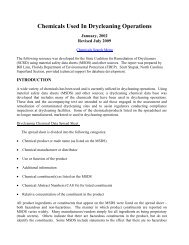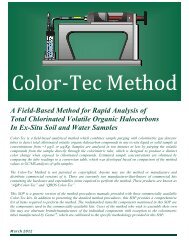Use of Environmental Forensics In Drycleaning Investigations
Use of Environmental Forensics In Drycleaning Investigations
Use of Environmental Forensics In Drycleaning Investigations
- No tags were found...
You also want an ePaper? Increase the reach of your titles
YUMPU automatically turns print PDFs into web optimized ePapers that Google loves.
<strong>Use</strong> <strong>of</strong> <strong>Environmental</strong> <strong>Forensics</strong><strong>In</strong> <strong>Drycleaning</strong> <strong>In</strong>vestigationsRobert D. Morrison, Ph.D.DPRA, <strong>In</strong>cHawi, HIState Coalition for Remediation <strong>of</strong>Drycleaners2009 Annual MeetingSan Antonio, TexasNovember 17-19, 2009
Forensic Issues in Drycleaner <strong>In</strong>vestigations• Apportionment in comingled plumes• Date/age <strong>of</strong> a contaminant release• Optimizing forensic sampling locations• Forensic analytical program• Cost
Presentation OutlinePCEWhere to sample?What to sample (media)?Analytical decisionsIsolating the PCE sourceCase study – multiple sources
Degradation Pathways <strong>of</strong> Four ChlorinatedSolvents
Synonyms for PCEChemical namesCarbon bichlorideCarbon dichlorideEthylene tetrachloridePerchloroethyleneTetrachloroethyleneTrade names AnkilostinBlacosolve No. 2Dee-SolvDidakeneDowPer (Dow Chemical)*Is<strong>of</strong>orm (Dow Chemical)MidsolvNemaPerclene (Du Pont, Diamond Shamrock)Perclene TG (Du Pont, Diamond Shamrock)PercosolvPer-ExPerklone (dry-cleaning)Perm-A-KleenPer Sec (Vulcan Materials)PhillsolvTetracapTetravecTetropilWecosol (Westinghouse)* Manufacturer names in italics.
PCE Applications (a)• <strong>Drycleaning</strong> (1960’s to 1980’s peak production years)• Metal cleaning/degreasing – especially for cleaningaluminum parts prior to the development <strong>of</strong>TCA stabilized (1,4-dioxane) formulations• Removal <strong>of</strong> wax and resin residue• Cleaning <strong>of</strong> small, low-mass partsbecause the condensed solventcontact time is longer than forother solvents• Automotive brake cleaning
PCE Applications (b)• Rubber dissolution• Paint Removal• Sulfur Recovery• Printing <strong>In</strong>k bleeding• Catalyst regeneration• Textile operations as a scouring agent• After 1966, primary use was in production <strong>of</strong> CFC-113and HFC- 134a
TCE in septictank cleaners
PCE Enriched via Solvent DistillationSIGHT GLASSFILTER BODYMUCK VALVEREGENERATIVE FILTERON A COOKER/STILLAUTOMATIC BUMPASSEMBLYPRESSURE GAUGETEMPERATURECONTROL BOXGAUGEPCE can be present in TCE, particularlyin degreasing grades because the twosolvents are produced by the sameprocess and are separated by fractionaldistillation. Other chlorinatedcompounds comprise 3 to 4 percent <strong>of</strong>degreasing-grade TCE.HANDLECOOKERSTILL BODYMOTORACCESS DOORWATERCLEAN OUTSEPARATORDOORThe boiling points <strong>of</strong> PCE and TCE are121.2 and 87.2°C, respectively. TCEdegreasers usually use hot watersomewhere below the boiling point <strong>of</strong>100°C. Because <strong>of</strong> this difference inboiling points, TCE volatilizes into theair and is lost from the degreaser at amuch more rapid rate than the PCE.
Major Manufacturers <strong>of</strong> PCECompanyApproximate Period <strong>of</strong> ManufactureDiamond Alkali/Diamond Shamrock 1950 ±1986Dow Chemical1923 ± presentE. I. Du Pont de Nemours 1933 ± 1986Ethyl Corporation 1967 ± 1983Frontier Chemical/Vulcan Materials1958 ± presentHooker Chemical/Occidental Chemical 1949 ± 1990Hooker-Detrex/Detrex Chemical 1947 ± 1971Pittsburgh Plate Glass/PPG <strong>In</strong>dustries1949 ± presentStauffer Chemical 1955 ± 1985Westvaco Chlorine 1940 ± 1945
Feedstock used for PCE Productionfor Age Dating PCEThe primary production method for PCE prior tothe 1970s involved the chlorination <strong>of</strong> acetyleneto produce PCE/TCE. By 1978, acetyleneproduction ceased.Subsequent productionmethods used ethylene asa feedstock to produceethylene dichloride (1,2DCA). <strong>In</strong> 1975, PCE productionwas 44% via propane chlorinolysis,35% via 1,2-DCA chlorination and3% by acetylene chlorination.
PCE/TCE Manufacturing Methods
The presence <strong>of</strong> 1,1,2,2-TeCA and/or 1,1,2-TCA withPCE suggests that the PCEwas manufactured priorto 1978.The presence <strong>of</strong> 1,2-DCAwith PCE (eliminate itspresence as a leadscavenger) indicates thatthe PCE was manufacturedpost 1978.
Chemical Name MW17S PBW-2 PBW-1 MW12D BD-17VOCsAcetone < 0.0500 < 0.0500 < 0.0500 < 0.0500 < 0.0500Benzene < 0.0050 < 0.0050 < 0.0050 < 0.0050 < 0.0050Bromobenzene < 0.0050 < 0.0050 < 0.0050 < 0.0050 < 0.0050Bromochloromethane < 0.0050 < 0.0050 < 0.0050 < 0.0050 < 0.0050Bromodichloromethane < 0.0020 < 0.0020 < 0.0020 < 0.0020 < 0.0020Brom<strong>of</strong>orm 0.003 < 0.0010 0.016 < 0.0010 0.009Bromomethane < 0.0098 < 0.0098 < 0.0098 < 0.0098 < 0.00982-Butanone < 0.0100 < 0.0100 < 0.0100 < 0.0100 < 0.0100n-Butylbenzene < 0.0050 < 0.0050 < 0.0050 < 0.0050 < 0.0050sec-Butylbenzene < 0.0050 < 0.0050 0.007 < 0.0050 < 0.0050tert-Butylbenzene < 0.0050 < 0.0050 < 0.0050 < 0.0050 < 0.0050Carbon disulfide < 0.0100 < 0.0100 < 0.0100 < 0.0100 < 0.0100Carbon tetrachloride < 0.0050 < 0.0050 < 0.0050 < 0.0050 < 0.0050Chlorobenzene < 0.0050 < 0.0050 < 0.0050 < 0.0050 < 0.0050Chloroethane < 0.0100 < 0.0100 < 0.0100 < 0.0100 < 0.0100Chlor<strong>of</strong>orm 0.0039 < 0.0002 0.034 < 0.0002 < 0.0002Chloromethane < 0.0100 < 0.0100 < 0.0100 < 0.0100 < 0.01002-Chlorotoluene < 0.0050 < 0.0050 < 0.0050 < 0.0050 < 0.00504-Chlorotoluene < 0.0050 < 0.0050 < 0.0050 < 0.0050 < 0.0050Dibromochloromethane < 0.0050 < 0.0050 < 0.0050 < 0.0050 < 0.0050Dibromomethane 0.043 < 0.0050 < 0.0050 0.086 < 0.00501,2-Dichlorobenzene < 0.0050 < 0.0050 < 0.0050 < 0.0050 < 0.00501,3-Dichlorobenzene < 0.0050 < 0.0050 < 0.0050 < 0.0050 < 0.00501,4-Dichlorobenzene < 0.0050 < 0.0050 < 0.0050 < 0.0050 < 0.0050Dichlorodifluoromethane 0.0036 < 0.0100 0.074 < 0.0100 < 0.01001,1-Dichloroethane < 0.0050 < 0.0050 < 0.0050 < 0.0050 < 0.00501,2-Dichloroethane < 0.0050 < 0.0050 < 0.0050 < 0.0050 < 0.00501,1-Dichloroethene < 0.0050 < 0.0050 < 0.0050 < 0.0050 < 0.0050cis-1,2-Dichloroethene < 0.0050 < 0.0050 < 0.0050 < 0.0050 < 0.0050trans-1,2-Dichloroethene < 0.0050 < 0.0050 < 0.0050 < 0.0050 < 0.00501,2-Dichloropropane < 0.0050 < 0.0050 < 0.0050 < 0.0050 < 0.00501,3-Dichloropropane < 0.0050 < 0.0050 < 0.0050 < 0.0050 < 0.00502,2-Dichloropropane < 0.0050 < 0.0050 < 0.0050 < 0.0050 < 0.00501,1-Dichloropropene < 0.0050 < 0.0050 < 0.0050 < 0.0050 < 0.0050cis-1,3-Dichloropropene < 0.0010 < 0.0010 < 0.0010 < 0.0010 < 0.0010trans-1,3-Dichloropropene < 0.0010 < 0.0010 < 0.0010 < 0.0010 < 0.0010Ethylbenzene 0.0050 0.045 < 0.0050 < 0.0050 < 0.0050Hexachlorobutadiene < 0.0100 < 0.0100 < 0.0100 < 0.0100 < 0.01002-Hexanone < 0.0050 < 0.0050 < 0.0050 < 0.0050 < 0.0050Isopropylbenzene < 0.0050 < 0.0050 < 0.0050 < 0.0050 < 0.0050p-Isopropyltoluene < 0.0050 < 0.0050 < 0.0050 < 0.0050 < 0.0050Methyl tert-butyl ether < 0.0050 < 0.0050 < 0.0050 < 0.0050 < 0.00504-Methyl-2-pentanone < 0.0050 < 0.0050 < 0.0050 < 0.0050 < 0.0050Methylene chloride < 0.0050 < 0.0050 < 0.0050 < 0.0050 < 0.0050n-Propylbenzene < 0.0050 < 0.0050 < 0.0050 < 0.0050 < 0.0050Styrene < 0.0050 < 0.0050 < 0.0050 < 0.0050 < 0.00501,1,1,2-Tetrachloroethane 0.09 0.007 0.78 0.0019 0.0241,1,2,2-Tetrachloroethane 0.01 < 0.0050 0.4 0.002 0.002Tetrachloroethene 0.155 0.047 0.523 0.145 0.067Toluene < 0.0050 < 0.0050 < 0.0050 < 0.0050 < 0.00501,2,3-Trichlorobenzene < 0.0050 < 0.0050 < 0.0050 < 0.0050 < 0.00501,2,4-Trichlorobenzene < 0.0050 < 0.0050 < 0.0050 < 0.0050 < 0.00501,1,1-Trichloroethane < 0.0050 < 0.0050 < 0.0050 < 0.0050 < 0.00501,1,2-Trichloroethane < 0.0050 < 0.0050 < 0.0050 < 0.0050 < 0.0050Trichloroethene 0.006 0.765 0.072 < 0.0050 0.015Trichlor<strong>of</strong>luoromethane < 0.0100 < 0.0100 < 0.0100 0.0271 < 0.01001,2,3-Trichloropropane < 0.0050 < 0.0050 < 0.0050 < 0.0050 < 0.00501,2,4-Trimethylbenzene < 0.0050 < 0.0050 < 0.0050 < 0.0050 < 0.00501,3,5-Trimethylbenzene < 0.0050 < 0.0050 < 0.0050 < 0.0050 < 0.0050Vinyl acetate < 0.0100 < 0.0100 < 0.0100 < 0.0100 < 0.0100Vinyl chloride < 0.0020 < 0.0020 < 0.0020 < 0.0020 < 0.0020Xylenes, Total < 0.0150 < 0.0150 < 0.0150 < 0.0150 < 0.0150
EPA Method 8270 – Substituted Phenols
Where/What to Sample?
Where to Sample?Knowledge <strong>of</strong> <strong>Drycleaning</strong> OperationUnderstand operational chronology, equipmentchronology, filter material, distillation still,equipment location, ancillary services, buildingmodifications/permits, sewer lines/connections,separator water connections, purchase/supplierrecords, equipment permits, insurance records.Visit Site Prior to SamplingIdentify piping, flooring, joints (wood, oakum,felt), sewer cleanouts, storm water, dumpsterlocations.
Knowledge <strong>of</strong> Equipment and Handling Practices
Traditional v. Forensic SamplingTraditional – Soil, soil gas, groundwaterForensic – Muck, sewer pipe, flooring, expansionjoints, filter material, asphalt/concrete pavingFlorida <strong>Drycleaning</strong> Solvent CleanupProgram on reported spills, leaks anddischarges <strong>of</strong> drycleaning solvent andsolvent-contaminated wastes at 334drycleaning facilities and 14 drycleaningwholesale supply facilities located inFlorida.
Optimizing Sampling Locations
Sources <strong>of</strong> Muck
Knowledge <strong>of</strong> Operations
Surrogate Chemical Signature Associated with LeatherFinishing at a Dry CleanerProduct Description <strong>In</strong>gredients Percentage by WeightLeather Spray Blue F2000Leather Spray Blood Red F2000Diisolbutyl ketone2,6-dimethyl-4-heptaone 28.5Butyl Cellosolve2-Butoxyethanol 4.8Titanium dioxide 2.2Dibutylphthlate 1.82-propoxethanol 1.4Diisolbutyl ketone2,6-dimethyl-4-heptaone 28.9Dibutyl phthlate 1.82-propoxyethanol 2.2Butyl cellosolve2-butoxyethanol 9.2Castor Oil exthoxylated 1.4Leather Spray Pure White F2000 Titanium Oxide 18.1Butyl cellosolve2-butoxyethanol 8.5Diisolbutyl ketone2,6-dimethyl-4-heptaone 25.1Leather Spray Orange F2000Diisolbutyl ketone2,6-dimethyl-4-heptaone 28.3N-butyl Alcohol 1-Butanol 1.2Disbutyl Phthlate 1.6Butyl cellosolve2-butoxyethanol 8.7Morrison, 2003. PCE contamination and the dry cleaning industry. <strong>Environmental</strong> Claims Journal. 15(1), 93-106.
Sediment/Muck in Cracks and Expansion JointsCracks/Multiple Pours
Muck from Expansion Joint Material(high probability sample)
Surrogate - Dry Cleaning FilterMaterial + PCE for Age DatingDiatomaceous Earth FilterActivated Carbon Filter
Case StudyExpansion Joint SamplingExpansion Joints
SEM <strong>of</strong> Paint Flakes and Rust
Sewer Videos – Sewer Sampling
Trial Graphic Depicting PCESources at a Dry Cleaner
Analytical DecisionsUnderstand the question - thendevelop the analytical program.
Forensic Techniques for PCE <strong>In</strong>vestigationsat Dry CleanersAdditives (inhibitors, anti-oxidants, etc)Surrogate chemicals and materialsDegradation rate approach (half-life rates)Molar ratio approachIsotopic analysis (soil, groundwater, indoor air)
PCE StabilizersAcid <strong>In</strong>hibitorsAcetylenic alcoholsAcetylenic carbinolsAcetylenic estersAlcoholsAliphatic aminesAliphatic monohydric alcoholsAmidesAminesAzo aromatic compoundsEpoxidesHydroxyl aromatic compoundsKetonesNitroso compoundsPyridinesMetal <strong>In</strong>hibitorsAlcoholsAromatic hydrocarbonsCyclic trimersEstersLactoneOxazolesOximesSulfonesSulfoxideLight <strong>In</strong>hibitorsAminesCyanideHydroxyl aromatic compoundsNitrilesOrgano-metallic compoundsAntioxidantsAcetylene ethersPhenolsPyrroleThiocyanatesStabilizers and PCE (synoposis)Unlike TCE and TCA, PCE is relatively stable and requires only minor amounts <strong>of</strong> stabilizingadditives to prevent decomposition. Earlier stabilizers included amines and hydrocarbons; morerecent stabilizers include compounds such as morpholine derivatives. <strong>In</strong> the presence <strong>of</strong> water,unstabilized PCE will slowly hydrolyze to form trichloroacetic acid and hydrochloric acid.
Is TCE a PCE degradation product ?TCE – Some Similarities(yellow) /Differences (white)Acid <strong>In</strong>hibitorsAcetylenic alcoholsAlcoholsAliphatic aminesAliphatic monohydric alcoholsAlkaloidsAlky HalidesAminesAzinesAzirdinesAzo-aromatic compoundsEpoxidesEssential oilsHydroxyl-aromatic compoundsNitroso compoundsOlefinsOrganic Substitute NH 4 hydroxidesOxiranePhenolsPyridinesPyrroleQuatenary Ammonium compoundsTerpenesMetal <strong>In</strong>hibitorsAlcoholsAmidesAminesAromatic hydrocarbonsComplex ethers and oxidesCyanideCyclic EthanesCyclic trimersEpoxidesEstersEthersKetonesOlefinsPeroxidesPyridinesOxazolesOxazolinesOximesSulfonesSulfoxideThiopheneAntioxidantAmidesAminesAromatic carboxylic acidsAryl stibineBoranesButylhydroxyanisolePhenolsPyridinesPyrroleThiocyanatesLight <strong>In</strong>hibitorTCEAromatic benzene nucleiBoranesEthersGuanidineHydroxyl-aromatic compoundsOrgano-metallic compounds
TCE StabilizersMetal stabilizers used with TCE include1,2-butylene oxide and epichlorohydrin.Epichlorohydrin wasdiscontinued in the1980s due to its toxicity.Accumulate in still bottomTCEresidue “muck” up to35% greater than their original compositionin TCE.
Stabilizers used in Dry Cleaning PCEEarly PCE stabilizers included amines andpetroleum hydrocarbons; more recentstabilizers included morpholine stabilizers.Stabilizers used in dry cleaning grade PCEinclude 4-methyl morpholine, N-butyl glycidylether (best marker), cyclohexane oxide,diallylamine and 3-methoxy proprionitrile.
Manufacturers <strong>of</strong> PCE for Dry Cleaningand Associated StabilizersDow Chemical 4-methyl morpholineVulcan Diallylamine/tripropylene compoundsPPG Cyclohexene oxide, beta-thoxyproprinitrile,m-nethyl morpholine, 4-methylphenol
Distinguishing Drycleaner fromTransformer/Metal Cleaning PCE (a)PCE was used in transformers as a replacement for the more toxic class <strong>of</strong> dielectricfluids containing PCBs.PCE used as a dielectric fluid was subjected to extra refining including scrubbing anddistillation and was stabilized with n-methyl pyrrole (112 C) and pentaphen (p-tert amylphenol) (226 C).<strong>Drycleaning</strong> grades <strong>of</strong> PCE did not use n-methyl pyrrole or pentaphen. May use thepresence <strong>of</strong> these two stabilizers with PCE to distinguish PCE originating from adrycleaners from one originating from a transformer.Patent literature indicates that metal degreasing metal cleaningPCE used n-methyl pyrrole as an oxidant containing 0.022 to0.028% stabilizer andnot for dry cleaning.N-methyl pyrrole was also used to stabilize TCA and TCE;pentaphen used to stabilize TCE against oxidation.
Distinguishing Drycleaner fromTransformer/Metal Cleaning PCE (b)Stabilizers in <strong>Drycleaning</strong>Grade PCE4-methyl morpholinediallylaminetripropylene compoundscyclohexane oxide3-methyl proprionitrilen-butyl glycidyl etherStabilizers in PCE forTransformersp‐tert amyl phenol (pentaphen)n‐methyl pyrrole
Metal Cleaning v. Dry Cleaning (a)Metal Cleaning Traditionally contained a higher concentration<strong>of</strong> additives than most dry cleaning grades. Classes include acidacceptors, antioxidants, and UV stabilizers. Antioxidants includeamine or phenolic compounds 50 – 200 ppm and acid acceptorsepoxide 0.2-0.7%. Early PCE formulations included alkylaminesand other hydrocarbons. Later stabilizers included morpholinederivatives, epoxides, esters and phenols.Dry Cleaning Traditionally contained a high concentration <strong>of</strong>additives, usually <strong>of</strong> a high purity and different types <strong>of</strong> additives.DOWPER-C-S contains a water soluble detergent, a corrosioninhibitor, an anti-static compound, “hand agent” compounds, anda fatty acid scavenger.
Metal Cleaning v. Dry Cleaning (b)Dry Cleaning PCE characterized by a high purity anddifferent types <strong>of</strong> additives than associated with metalcleaning. For example, DOWPER-C-S contains awater soluble detergent, a corrosion inhibitor, an antistaticcompound, “hand agent” compounds, and afatty acid scavenger.
Surrogate ApproachPCE from SewersSurfactants (a) amine alkylarenesulfonates(b) Sodium alkylarenesulfonates, (c) petroleumSulfonates, (d) ethoxylated phenols and (e)ethoxylated phosphate esters. <strong>Use</strong> MBAS for presence/absence as an inexpensive surrogate for detergents.Generic <strong>In</strong>dicators (a) high TDS values, (b)presence <strong>of</strong> trihalomethanes, (c) microbiological,(d) soil gas (methane, etc).
Co-mingled PCE-SeparateSources• PCE from two sources chemically identical• May be isotopically different• Carbon and Chlorine stable isotope ratios• 13 C/ 12 C and 37 Cl/ 35 Cl• May differentiate sources prior to comingling• Effects <strong>of</strong> biodegradation need to beconsideredClClCCClCL
-20.00-22.00-24.00TCE-26.00-28.00-30.00-32.00-34.00-28.00-27.00-26.00-25.00PCESource: Philp, P., 2003. Stable isotopes and biomarkers in Forensic chemistry. <strong>In</strong>ternational Society <strong>of</strong> <strong>Environmental</strong> <strong>Forensics</strong> Workshop.May 19-20 th , 2003. Stresa, Italy.-24.00-23.00-22.00-21.00-20.00
Isotopic Analysis for Source Discrimination
<strong>Use</strong> <strong>of</strong> C and Cl Isotopes to DifferentiatePCE/TCE Sources
Degradation Rate Approach
Molar Ratio Approach
THANK YOU





